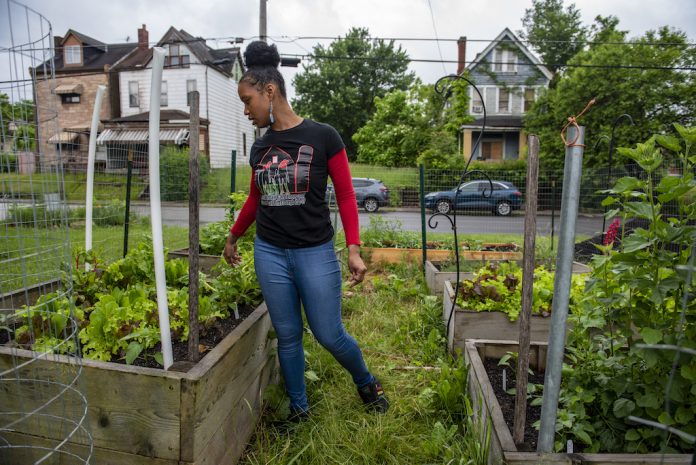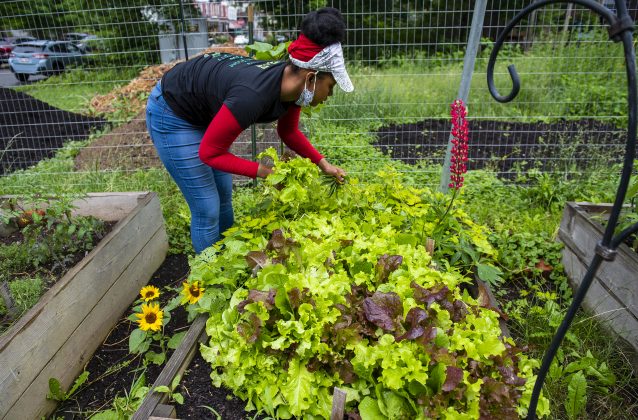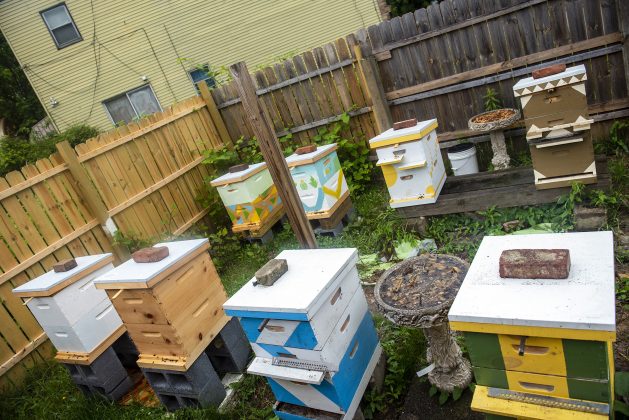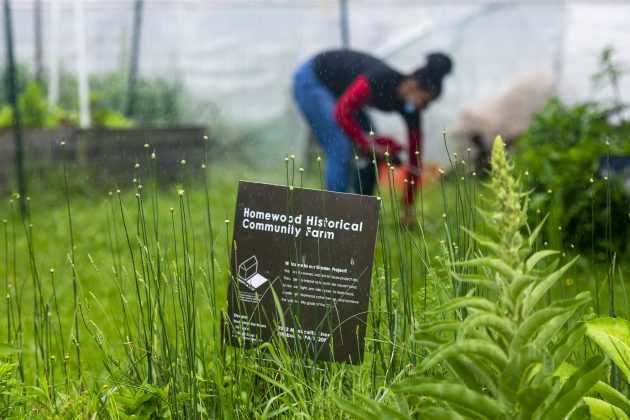
*Updated 6/11 to indicate that a federal judge placed a temporary restraining order on a debt relief program for socially disadvantaged farmers included in the American Rescue Plan, in response to a lawsuit.
So, you want to farm. You know you need land. Equipment. Access to capital, knowledge, education and mentorships.
Maybe you don’t come from a farming family. You have to seek out some of those things more deliberately, and with fewer connections. It might be a little harder, but it’s still doable.
But maybe your family did have those things, once. Maybe it was taken from them. Maybe they were pushed out of agriculture. And maybe it still seems like some people don’t want your family in farming.
That’s the reality for many Black farmers, even to this day.
White farmers own about 98% of farmland. They received the bulk of U.S. Department of Agriculture pandemic relief in 2020 — Black farmers only got about 0.1%, agriculture secretary Tom Vilsack told the Washington Post earlier this year. About 95% of farmers are white. Only a little over 1% are Black.
It took Caressa Brown, a Black farmer, in Dayton, Ohio, years to convince her dad to teach her to garden. She’s always wanted a garden. She dreams of having a small farm, with a bed and breakfast on it.
But farming was viewed as a negative thing in her family. Her dad had a garden and preserved food. But he wouldn’t teach her. He wanted her to focus on her education. Farming was tied to slavery. It was what poor people did.
That attitude came directly from her family’s history in agriculture. Her dad grew up in a sharecropping family, in Alabama. Her grandpa worked for a white family, who would pay them in advance at the end of one season so they would have to stay and work that money off over the next spring and summer.
Her grandpa would often hear about the great American dream. But his 3-year-old son was helping pick cotton in a field for a white family. He was fed up.
“It was like a different form of slavery,” Brown said.
Eventually, at the end of a season, after getting the advance for the next season, her grandpa packed up his family and moved to Texas. They had to move around in the state so her dad and his siblings could get an education. Some schools would teach only Black students in certain grades. Brown’s father finished his education, after several moves, went into the military and later settled in Dayton.
Brown considers herself the first generation in her family born free. She was able to get her education in one city. She wasn’t stuck in a sharecropping situation. She was one of the first people in her family to get a college degree.
And finally, in 2019, at age 39, she convinced her dad to help her start a garden. She loved it.
Kenisha Robinson, one of her childhood friends, saw Brown’s posts on Facebook about wanting to get into farming more. Robinson’s family has an 8-acre farm, in the Dayton area, that wasn’t being used for anything at the time. So, she invited Brown to farm there. In 2020, they got started. Brown launched Veggie Soul: The Urban Farmers Market, and Robinson launched her own farm, Nourganic Life Farm.
LONG HISTORY
The history of Black farmers in the Midwest is not recent. Historians noted there were significant numbers of Black farmers in the Midwest in the 19th century, in “Feeding Family and Community: African American Women Farmers and the Long Fight for Environmental Justice in the Midwest, 1790-2021,” a webinar from Harvard University’s Warren Center, April 19.
It’s important to recognize that much of the history of Black farmers, especially Black women, in the Midwest has been ignored or deliberately erased, panelists said. Even written records, like census data, can be misreported.
Many of these early Black farmers faced racial discrimination, like being barred from voting at some points. Many lost their land or were pushed out of farming. That pattern continued, though the specifics may have changed, through the following centuries, even to this day.
Shakara Tyler, board president for the Detroit Black Community Food Security Network, said during the panel that many Black folks also don’t want to farm because of how the history of enslavement and agriculture connect. Part of addressing that is unpacking how Black folks see themselves in relation to the land, she said.
Farmland loss and land access is still a major issue for Black farmers. If your family lost farmland or was never able to get it to begin with, you’re not likely to be in a position to inherit a farm. In 1920, there were about a million Black farmers. Now, there are only about 48,000. The overall number of farmers has declined too, but not nearly as quickly.
“It’s kind of disheartening, actually,” Robinson said.
USDA PRACTICES
So what are the reasons for that decrease in numbers and land ownership?
There are multiple factors, but discrimination in USDA lending and aid is one of the big ones. A lot of farmers rely on loans to get started, to keep going or to expand. Many receive aid from the USDA during tough times, like the pandemic, the trade war and the terrible planting season many had in 2019.
But the USDA has often denied Black farmers loans and other aid that would help them get into or stay in business. The disproportionately low share of pandemic aid that went to Black farmers is nothing new. That’s been happening for years.
“Lack of equal access to federal farm loan programs is a big reason for the land loss,” said Rep. David Scott, D-Georgia, chairman of the House agriculture committee, in a 2021 hearing about the state of Black farmers. “Most farmers who can’t get a loan are simply not farming.”
“If I can’t compete in farm subsidy programs and receive subsidies, like them, I can’t compete,” said John Boyd Jr., president and founder of the National Black Farmers Association, in the same hearing. “This hasn’t just begun. This has been going on for decades.”
Black farmers filed several class action lawsuits in the 1990s, and the USDA agreed to a settlement in the Pigford v. Glickman lawsuit in 1997.
Though the federal government paid out more than $1 billion to claimants by the end of 2011, many applicants never got a decision back on whether they were eligible for claims. And the settlements didn’t undo the loss of family legacies and land, or end discrimination. Boyd referenced a backlog of complaints about discrimination at the USDA that haven’t been addressed yet. Complaints often take years to be addressed.
The American Rescue Plan, a COVID-19 relief bill that passed Congress earlier this year, includes $4 billion for debt relief for Black and other socially disadvantaged farmers. It also included about $1 billion for the USDA to create a racial equity commission and address longstanding discrimination through things like more technical assistance for farmers of color.
That move has been met with backlash from some Midwestern white farmers, who filed a lawsuit claiming the program violates their rights. Several banking groups have also argued the program would take interest income from them.
In response to a lawsuit, a federal judge in Wisconsin handed down a temporary restraining order on the program June 10, the Milwaukee Journal Sentinel reported.
In a May 22 press conference at Fort Valley State University, in Georgia, Vilsack noted the banks charge a prepayment penalty, which should cover that situation, The Counter reported. He also pointed out that this aid targeted towards Black farmers and other socially disadvantaged farmers is a response to a long history of discrimination.
Panelists in the Warren Center webinar said it’s important to recognize the extent of the damage that’s been done. Some farming families have stopped even applying for loans, knowing they are likely to be rejected or have the loans used to steal their land, said Anna-Lisa Cox, historian and fellow at Harvard’s Hutchins Center for African and African American Research.
“Even programs like loan forgiveness don’t meet the needs of this particular population in certain ways,” Cox said.
“It’s going to take more than one person, more than one act, to reverse 98% of farmland being owned by white farmers,” Brown said. “Property is wealth … if the African-American community doesn’t have access to get property, we will never be wealthy enough to be farmers, so we’ll always be operating somebody else’s land.”
OPTIONS
If your family doesn’t have a farm, that presents challenges beyond just land access. Depending on where you live and who is around you, you might not even realize farming is an option.
[Agriculture is] a big business, and it’s huge here in Ohio … but if you don’t know that, how can you potentially pursue a career of that sort?
In the mostly Black school district she grew up in, “Nobody was going to be a farmer,” Brown said. “Learning how to grow your own food is not something that is taught.”
While there are Black folks in rural areas, most members of minority groups are in larger, metropolitan cities, said Ariella Brown Horn, coordinator of the Black Farming Network and associate director of gender equity programs and education at Antioch College, in Yellow Springs, Ohio.
“[Agriculture is] a big business, and it’s huge here in Ohio … but if you don’t know that, how can you potentially pursue a career of that sort?” Brown Horn said.
For example, her cousin wants to be a veterinarian. But she grew up in the suburbs, in Cuyahoga County, and was never involved in 4-H or other agricultural organizations.
“She’s already kind of going to be behind the eight ball,” Brown Horn said. “She just has not had that exposure … a lot of it just comes down to lack of access.”
RESOURCES
Brown Horn was only aware of one Black farmer in Ohio who is farming on a larger scale. Most of the farmers in the network are on a relatively smaller scale. The average size of Black operated farms is 132 acres, while the average farm size overall is about 440 acres, according to USDA data.
“Clearly, racism plays a part in that … if you weren’t able to keep your land, for whatever reason,” she said.
Robinson’s family has some land, and some history in agriculture. But the property hasn’t been used in almost 20 years. Her grandfather owned a farm and raised horses, chickens and a large garden. Her dad bought land and raised hogs. He also had a cornfield and large gardens to grow for his family. He shared some of the space with other family members who wanted to grow their own food.
Robinson didn’t get that much experience with farming growing up, though. She’s the youngest of five children by about 20 years.
“My experience growing up on the farm was much different than theirs. They had experience working on the farm — I don’t,” she said. “I didn’t have to, and I wasn’t really interested in it, because I was scared of everything.”
But last year, she fell so in love with farming and restoring the property that she left her full-time job in August. Now, she focuses on farming and getting the training and education she needs to make her vision happen.
“I never, ever, ever would have thought that I’d be doing what I’m doing now. Nobody in my family would have said that either,” Robinson said.
Robinson wants to restore the farm back to its original aesthetics. Down the road, she may add chickens and bees to the farm. She hopes to sell at markets this year and eventually start a CSA.
It’s been a little overwhelming. But she’s been learning through various programs, organizations, YouTube videos and people. The first year was a lot of trial and error.
“There’s so many different ways that you can farm. There’s no-till, the traditional farming, all these other different methods that people use — it’s confusing,” Robinson said.
Brown and Robinson have learned through a wide range of programs and groups, which have helped them not only with farming, but also with the business side of agriculture. They’ve also had help from some older folks in the area with farming experience.
Robinson is in a beginning farmers program with Agraria, a center for research and education on regenerative land use through the Arthur Morgan Institute for Community Solutions, in Yellow Springs. Agraria has a grant to pilot a new and beginning regenerative farmer program targeted at people of color who are aspiring or new farmers.
“I feel like just the average person doesn’t really know how many resources there are available to them,” Brown Horn said. “Sometimes, you just kind of have to ask the question.”
Connections
The Black Farming Network that Brown Horn coordinates is trying to connect Black farmers with each other and with other resources.
It was sparked after the Black Farming: Beyond “40 Acres and a Mule” conference in 2020, which Brown Horn also helped plan. The network is planning another conference for 2021, as well as holding roundtables for underrepresented farmers in the area.
“There’s so many different types of farming that’s happening in our backyards, but a lot of times, you just don’t even know what’s happening in your own backyard,” Brown Horn said.
She is from the Cleveland area, and much of her experience is connected to urban farming.
“I do think that there are a lot more Black farmers clearly in the southern region of the state, but it’s just difficult to identify them. They definitely exist,” Brown Horn said. “That’s one of the things that we as a committee … are still trying to identify.”
Some of the common challenges Robinson hears from other farmers at roundtables with the Black Farming Network are land access and dealing with rural communities that aren’t very diverse.
Growing up, most of the rural communities Robinson knew of were mostly white.
“A lot of these rural communities are not welcoming of people of color,” Robinson said. “To me, they just never seemed open to diversity, and people normally stayed away from those areas because they knew it wasn’t very welcoming … I guess it kind of depends on the community, but that has been a concern or a challenge that some of the farmers said they’d faced.”
Robinson sees a lot of programs popping up wanting to support people of color in farming right now. She thinks those types of programs can be very helpful in addressing some challenges and connecting new farmers to resources. But she thinks it’s still difficult for people to get started farming at a large scale.
“I think it’s easier to start on that [smaller] scale because there are people out here now who are wanting to help people to gain the knowledge and direct them to different grants and funding opportunities that are out there,” she said. “For people interested in a larger scale, I think there’s definitely going to have to be conversations.”
JUSTICE
Paying attention to and getting involved with local communities and elected officials can help farmers be part of those conversations, whether as large farms or small farms. Sometimes, local Congressional members can write a letter of support for a farmer applying for a grant. Sometimes, community members and groups can help farmers get access to resources they need.
It’s very important to us that Black farmers lead Black farmers.
Raqueeb Bey has been working with community gardens in Pittsburgh since the early 2000s. She has a background in activism, and over time, started to notice that urban agriculture was often left out of grants or didn’t have much of a voice in policy discussions.
“I noticed they were making policy for urban agriculture … we weren’t at the table,” she said.
In 2015, she started the Black Urban Gardeners and Farmers of Pittsburgh Co-op with 11 other growers in the area. They wanted to make sure they had a voice, as Black gardeners and farmers in the city.
They picked Homewood, a neighborhood with a population of about 6,000, to work with and try to address a local food apartheid — a similar term to “food desert” that recognizes the systemic healthy food access challenges in an area and the ways discrimination contributes to and causes those challenges. They started the Homewood Historical Community Farm on a city-owned vacant lot.
“We’re not just growing food, but growing minds as well,” Bey said.
Now, Bey says, she feels Black farmers in the area have a voice at the table. She’s glad the USDA has issued a plan to address injustice against Black farmers. She thinks the work done in Pittsburgh has helped change how urban agriculture is viewed. But she wants to go a step forward to see Black farmers have their own table, so to speak.
“It’s very important to us that Black farmers lead Black farmers,” she said.
The group has volunteers of multiple races and is fine with that. But there’s still a fight for social justice, and Black farmers and communities have been treated unjustly for years. Bey and her group are working on ways to ensure that Black farmers in the area can get and keep land access for farming.
“This land has been stolen from us. It’s happened for generations,” she said. “We have to get our land back.”
COMMUNITY
Brown sees farming as a way to help feed her community and to influence culture change in the area. Around the time she and Robinson started farming, one of the last grocery stores in the West Dayton and Trotwood areas left.
This year, Brown is trying to get a traveling farmers market off the ground. She had things lined up with some local churches for a market in 2020, but the pandemic shut that down. Instead, she worked with some community members to teach them how to garden and donated much of the food she grew to family and friends in the area.
She believes getting back to the land and growing food, instead of eating fast food, can help address health issues like diabetes and obesity in her community.
“Culture shift is the end goal,” she said.
She is looking for other people, of any race, to join the market as vendors. She wants Veggie Soul to bring the community together and celebrate differences, while promoting health.
“This 2021 has to be a year of healing,” Brown said. “This is a community outreach, and when I say that, everyone is included.”
Down the road, she wants to teach people in the West Dayton neighborhood how to plant and preserve gardens. She also wants to develop an after school program and help students learn more about farming and the power that comes with growing your own food.
“There’s so many things that I’m still learning, at 41, that I just wasn’t taught,” she said. “You don’t know what you don’t know.”

ONGOING DISCUSSIONS
At the federal level, there are still ongoing discussions about how to address decades and centuries of discrimination against Black farmers and other farmers of color.
Many have suggested different forms of reparations to help address that inequity. In addition to the American Rescue Plan, bills like the Justice for Black Farmers Act seek to explore things like civil rights reforms at the USDA, offering land grants to Black farmers, funding for historically Black colleges and universities, adding protections for land ownership and increasing credit access for minority farmers.
“It’s not anything different than what this country did for white people,” said Christy Clark-Pujara, a historian and professor with the University of Wisconsin and panelist in the Warren Center webinar. “How did white people end up owning so much land?”
The Homestead Act, low-interest loans and other support from the federal government and other agencies helped many white farmers out years ago. Land ownership and home ownership has allowed them to build wealth over the years. Black farmers, and Black folks in general, were largely left out of that process. Clark-Pujara wants to see the same thing done for Black farmers.
“It’s not like they were working harder,” she said. “They had access to something that other groups did not have access to.”















Thank you for this kind of reporting. These are stories that need to be told.